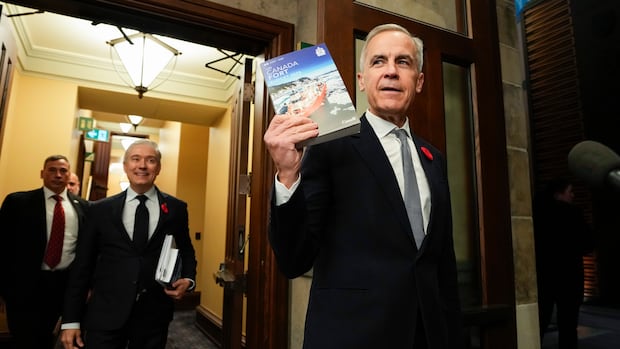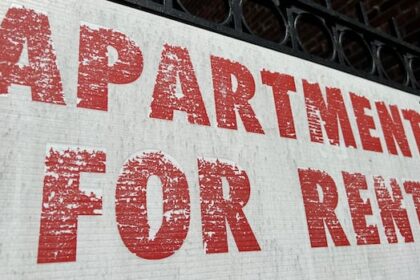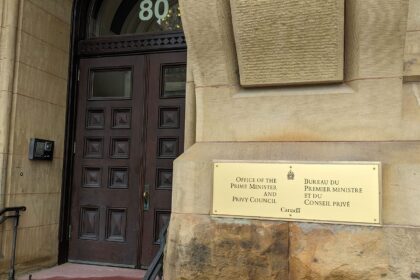Finance Minister François-Philippe Champagne presented his first federal budget Tuesday and it includes big-ticket items to prop up an economy grappling with major economic disruptions but also cuts to the public service to get the fiscal house in order.Champagne’s document shows a deficit of roughly $78 billion for the 2025-26 fiscal year — a figure that is lower than some economists had expected but still much higher than what the last Liberal government said it would be before U.S. President Donald Trump launched his trade war.All told, this budget calls for some $141 billion in new spending over the next five years, which will partially be offset by some $51.2 billion in cuts and other savings.The 406-page budget paints a gloomy picture of the country’s economic outlook — unemployment is up, business uncertainty has spiked and productivity is weak.Live updates: Budget 2025The budget projects the economy will grow, but not by much — about one per cent a year for the next two years, well below projections made late last year.“The level of uncertainty is higher than what we have seen and felt for generations,” Champagne said in his budget speech. “Bold and swift action is needed. To weather the storm of uncertainty, we will not lower our sails, that would be un-Canadian. Quite the opposite. We will raise them — to catch the winds of economic change.”To try and turn things around, the government is pitching massive investments in infrastructure, housing, the military and tax changes to spur business development as Prime Minister Mark Carney drives to bolster Canada’s self-sufficiency and put people to work.Budget highlights:$141 billion more over the next five years — offset by $51.2 billion in cuts and savings.A $78-billion deficit this fiscal year — lower than some economists had expected.Slashes in bureaucracy by nearly 40,000 jobs through buyouts, attrition.$51 billion for infrastructure to spur development.Major projects like high-speed rail, new ports, carbon capture and storage face likely approval in the coming months.An $81-billion funding package for the Canadian Armed Forces — including a Buy Canadian procurement plan.Immigration getting slashed — with temporary residents like students and foreign workers to be cut by nearly 50 per cent.The previously proposed emissions cap could be scrapped.Sahir Khan, a former deputy parliamentary budget officer and an expert on Canada’s finances, said the projected deficit, while relatively high, is manageable.The debt-servicing costs are rising to $55.6 billion this year, which means more of every dollar the government takes in is going to pay Canada’s bondholders.Still, “everybody in the G7 would gladly trade positions with Canada,” Khan said. “There is no fiscal crisis and we’re not on any precipice.”The budget also includes a plan to slash immigration after years of what this government describes as unsustainable growth — temporary foreign workers and students will see the steepest cuts with admissions falling by about half.The government also lays out a path to do away with the proposed Trudeau-era emissions cap that was loathed by the energy sector and some leaders in Western Canada.While both changes could prove controversial, the intent is to help more homegrown workers get a job and unleash an oil and gas sector that could deliver outsized returns.As for spending cuts, this budget proposes downsizing the public service, which has gone through explosive growth in the post-COVID era.These cuts will be achieved through what Ottawa calls a “workforce adjustment” — Ottawa will offer buyouts for some eligible bureaucrats — and attrition to whittle the public service down from a peak of 368,000 to 330,000 by the end of 2028-29.Some programs, like planting two billion trees, are being scaled back. Ottawa will also pay less for medical cannabis for veterans, change how public sector pension payments are indexed for inflation, consolidate diplomatic properties abroad and dial back foreign aid to pre-pandemic levels, among dozens of other proposed changes to save the federal treasury tens of billions of dollars.Those funds will also be ploughed into new projects. Touting Canada “as a proud nation of builders,” the centrepiece of Champagne’s agenda is a $51-billion infrastructure program called the “build communities strong fund,” designed to turbocharge construction of everything from roads, ports, hospitals and medical schools to community centres, parks and transit — although initial details on what exactly will be funded are scant.The budget also details some of the major projects the government has identified as likely contenders for fast-tracked federal approval in the coming months, including high-speed rail between Toronto and Quebec City — the budget promises to cut the construction start time in half — expanded port facilities in Churchill, Man., critical minerals development throughout the country and an Alberta-based carbon capture and storage system called “pathways plus” to slash emissions in the oil sands, among other initiatives.As Canada stares down an increasingly protectionist U.S. that is trying to draw businesses and jobs away, the budget is launching what the government calls “a productivity super-deduction,” which will allow businesses to write off a larger share of new capital investments right away on their taxes.This makes it much more attractive for companies to invest in machinery, equipment and technology while also rendering Canada’s tax code more competitive compared to the American one after Trump slashed taxes through his recent “big, beautiful bill.”After this change, Canada’s marginal effective tax rate for corporations will be the lowest in the G7, which Champagne hopes will encourage skittish businesses to invest more at home.”We’re starting a new era. We know the world’s changed, our strategy has to change with it and we choose Canada. We choose to advance. We choose to invest,” Carney told reporters just before the budget was tabled in the House of Commons.”Historical investment, generational investment,” he said.Other measures to encourage investment include $2 billion for a “critical minerals sovereign fund,” which will help unlock natural resources that are crucial for the development of new technologies.There are also measures to make developing “low-carbon” liquefied natural gas (LNG) more cost-effective through tax incentives — something that comes at a time when partners in Asia and Europe are anxious to get more of that fossil fuel from Canada.There’s also a dedicated $925-million artificial intelligence (AI) fund, which Carney has identified as a priority.Capital and operational spending are being reported separately for the first time in this budget.Capital spending is what the government spends on infrastructure and other fixed assets — the government says it’s anything that “contributes to public or private sectoral capital formation” — whereas operational spending is costs like public servant salaries and benefits and money for transfers to people and provinces.While the overall deficit will remain relatively high for the foreseeable future — there is no plan to balance the budget in this document — almost all of it is on planned capital spending like housing, infrastructure and the military while the operational budget will be balanced after public service cuts.Khan said the Carney government is making a hard pivot from a past focus on social programs to bolstering the country’s industrial policy to stanch Trump-induced bleeding — capital investments that could also draw more private sector investment and bear fruit in the coming years. “In the end, it’s all about execution. That was the Achilles’ heel of the last government,” Khan said. As for housing, the budget includes previously announced plans to dramatically scale up home construction through a new federal agency called Build Canada Homes.With an initial $13 billion investment over five years, the government is projecting tens of thousands of units will be built by prioritizing what it calls “innovative, factory-built housing” and other affordable homes.Prime Minister Mark Carney announced the creation of the new federal agency Build Canada Homes in September. (Justin Tang/The Canadian Press)Canada is also ramping up its military spending dramatically as it aims to reach NATO targets after years of being a laggard. The budget is earmarking $81.8 billion over five years to “rebuild, rearm and reinvest” in the Canadian Armed Forces with an emphasis on recruiting and retaining more personnel and buying new equipment, which the government wants to be made in Canada wherever possible as part of a new Buy Canadian procurement strategy.Dave Perry, an expert on defence and the president and CEO of the Canadian Global Affairs Institute, said it’s the most money the federal government has spent on the military in generations.“There’s an enormous injection in just a five-year period,” he said. “You’re seeing a huge reallocation in terms of what the federal government does and more of it is moving to defence. It’s a hell of a lot.”WATCH | Finance minister tables Carney government’s 1st budget :FULL SPEECH: Finance minister tables Carney government’s 1st budgetFinance Minister François-Philippe Champagne delivered the new Liberal government’s first budget on Tuesday, presenting it as a budget that will ‘catalyze’ investment across the country. The budget, which offers up billions in spending, comes as Canadians feel the strain of rising unemployment and an ongoing fight with the U.S. over trade.There are some measures that seem to be designed to possibly curry support with opposition parties — or, at least, some of their MPs.The budget includes $40 million over two years for a Youth Climate Corps, which will provide paid skills training for young Canadians — an NDP request.There’s also $150 million in new funding for CBC/Radio-Canada to modernize and “strengthen its mandate,” which the Bloc Québécois has demanded in the past. The government said it will work with the public broadcaster to “explore participation in Eurovision,” the popular song contest.The minority Liberal government has 169 seats in the House of Commons and needs at least three members of the opposition to support the budget if it has any chance of passing — although that number could fall to two if the Speaker is willing to break a tie. That equation could also change if some members abstain on the vote.So far, the government doesn’t have the necessary support.Conservative Leader Pierre Poilievre told the Commons that his MPs would not vote for the budget.“The Liberals have introduced the most costly and largest budget deficit in Canadian history outside of COVID. The cost of this Liberal budget will drive up the cost of food, housing and everything else Canadians buy,” Poilievre said.“Conservatives will not be able to support this budget.”WATCH | Poilievre: ‘We Conservatives cannot support this costly Liberal budget’ :Poilievre: ‘We Conservatives cannot support this costly Liberal budget’Conservative Leader Pierre Poilievre, speaking in the House of Commons on Tuesday after the Liberal finance minister tabled the 2025 federal budget, said his party will put forward an amendment to the budget aimed at ‘making Canada affordable again.’Bloc Québécois Leader Yves-François Blanchet also said he can’t see how his party will support this budget given it includes none of his party’s demands to spend a lot more on Quebec and supports for seniors, among other things.“This is a red conservative budget which Mr. Harper might have signed, and there is nothing in there for Quebecers,” he said.NDP interim Leader Don Davies praised the budget’s investment in infrastructure but raised some concerns about the coming cuts.He said his seven-member caucus will meet Wednesday to discuss how to approach the budget vote, which could include abstaining.
Carney’s 1st budget calls for billions in new spending to prop up tariff-hit economy











